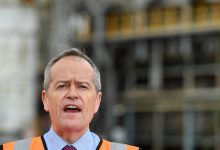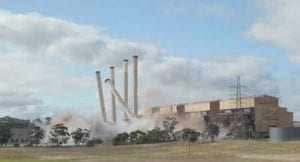Federal ALP has several separate emission policies
ALP’s 50 per cent renewable electricity policy was released in December. It’s an excellent policy that reveals how much work climate change spokesman Mark Butler has put in. Electricity is responsible for about 32 per cent of Australia’s carbon emissions and the policy would/will reduce those emissions by about 60 Mt (megatonnes).
The new element of the policy is a sketch of the 45 per cent emissions reduction target by 2030. If the EITE (emissions intensive trade exposed) sector is excused from making any contribution then we will be surprised if the total of all ALP policies can bring about more than 100 Mt of emission reduction.

We get a less than 20 per cent carbon reduction from the announced policy. Actually, we only add up 15 per cent, but electric vehicles and changes in land clearing could assist as well.
Of course, the big issue is EITE business. Our table is calculated on the basis of total exemption, but clearly if the world is going to decarbonise rapidly, and it is, the EITE sector cannot escape decarbonisation requirements forever. ALP policy is for doing the same as international competitors in this sector. The truth is that aiming at the average tends to lead to the average not moving.
This note proceeds by quickly looking at emissions by source, then the recent announcements on the 45 per cent announcement, and a brief reminder of the previously announced electricity policy.
Once more unto the emissions breach dear friends, once more
This graph or some equivalent should eventually be imprinted on our subconscious.

45% emissions reduction policy
Only a few points have really been released about the 45 per cent emissions reduction policy.
The plan covers non electricity facilities emitting more that 25 Kt and those facilities will have to reduce emissions by 45 per cent.
Emissions intensive, trade exposed industries [EITE] will have “tailored” policies that conceptually allow them to face comparable impacts as international competitors. Good luck with that, but management in those industries will see it as being the thin end of the inevitable wedge. It is not a blanket exemption, but in the short term it probably will be seen as such.
Elements of cap and trade
To meet the obligations facilities can:
- Reduce emissions;
- Buy permits from facilities that have reduced below their baseline;
- Buy international permits
- Buy ACCUs (these are basically carbon farming permits);
- Potentially buy generation offsets. This is the most important leg as it will connect the electricity sector back to the broader emissions target and allow extra achievement in electricity to be properly rewarded. Of course there is no detail.
How much CO2 do covered facilities emit?
According to the National Greenhouse Accounts, there were 291 facilities with emissions over 25 Kt and totaling about 335 mt.
Based on our general knowledge of the name of the facility and its business we classified the top 100 of these facilities into electricity sector, EITE or other. Its really only the “other” sector that faces the certainty of being required to cut by 45%.

The top 10 potentially EITE exempt are:
And the top 10 that might be covered might be:
Excellent electricity policy, but its only a 1/3 reduction in carbon output from today’s level
ALP’s 50% renewable electricity in the NEM by 2030 is, in our view, a well thought out, clearly achievable policy that will lock in reasonably rapid decarbonization of electricity generation and assist in building a “fit for purpose” 21stcentury grid.
The electricity policy works through an existing institution the CEFC, has clearly been developed with an eye to progressing AEMO’s ISP and to overcoming difficulties in building out a 21stcentury transmission system.
The electricity policy as a reminder includes
1. $10 bn to the CEFC over the period to 2025 to fund:
- reverse auctions for wind, solar and storage projects;
- Support the ALP’s proposed household battery program via concessional loans (100,000 households can get a $2000 grant). 2025 target of 1 mn households.Lets be honest household batteries are not taking off right now. Prices have gone up in the past two years and who cares why. Car battery prices are down, utility scale battery prices are down but house battery prices are up or at best flat.
- Boost energy efficiency
2. Establish an “Energy Security Fund” with $5 bn of capital which will explicitly use the Integrated System Plan [ISP] as its base to develop transmission infrastructure including into Renewable Energy Zones. Its becoming clearer and clearer that this is the most important element of the policy or at least as important as the reverse auctions.
Here at ITK we are 100% supportive of this policy suite. Here at ITK we suggested in 2016 in a Reneweconomy note using the CEFC to run reverse auctions. As far as we know this was the first public call for using the CEFC to do this.
It’s now likely to become government policy.
We believe reverse auctions provide a low-touch way for federal policy to guide investment without owning or controlling it or gaining day to day operational management.
The auctions incentivise competition, provide visibility, and this together with the revenue guarantee drives downs costs to consumers. It will certainly require the CEFC to be efficiently run. Reverse auctions have disadvantages, increasing the influence of government ownership, but on balance we like them.
We’ve also written several articles over the years jumping up and down about the need to develop transmission and how getting transmission done in Texas made development of wind and now solar much quicker.
The slowness in developing transmission is the single biggest factor holding back 50% renewables in Australia. In 2016 we were promoting a South Australia-NSW interconnector. As an indication of how long it takes, that project is still yet to satisfy all the regulatory tests.
ALP’s target of 1 million household batteries by 2025 will need to be linked to other policies to ensure those batteries benefit the system as much as the individual household, but broadly will increase resilience of the distribution grid, increase consumer control and help to reduce the need for utility-scale daily peakers.
Batteries at the boundary of the grid, that is behind the meter, are broadly more valuable to consumers and to the system than those located at the other end of transmission lines.










